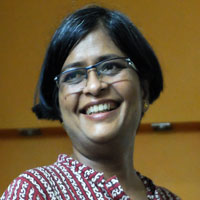Smita Dalvi
Tekton
Volume 3, Issue 1, March 2016
pp. 46 – 63
 Smita Dalvi is a founding faculty of MES Pillai College of Architecture, Navi Mumbai and the editor of Tekton. She has been teaching architecture and aesthetics in Navi Mumbai and Mumbai. Her research areas are in Architecture, History of Art & Culture, Urban Heritage and has read and published papers and essays in conferences and several architectural and cultural journals. Her area of special interest is Islamic architecture and aesthetics. In 2007, she was awarded the fellowship of ‘Fulbright Visiting Specialist: Direct Access to the Muslim world’. Presently, she is pursuing her doctoral studies at IIT- Bombay.
Smita Dalvi is a founding faculty of MES Pillai College of Architecture, Navi Mumbai and the editor of Tekton. She has been teaching architecture and aesthetics in Navi Mumbai and Mumbai. Her research areas are in Architecture, History of Art & Culture, Urban Heritage and has read and published papers and essays in conferences and several architectural and cultural journals. Her area of special interest is Islamic architecture and aesthetics. In 2007, she was awarded the fellowship of ‘Fulbright Visiting Specialist: Direct Access to the Muslim world’. Presently, she is pursuing her doctoral studies at IIT- Bombay.
ABSTRACT
This paper is based on an eponymous exhibition held between 09 February & 11 March 2016, at the lobby of Army & Navy Building, Kalaghoda, Mumbai — a collateral event with the ‘State of Architecture’ exhibition at the NGMA, Mumbai. The curatorial text by Smita Dalvi is based on ongoing research on the building and the early modernism in India. The drawings for the exhibition were prepared by Raj Singh and Amit Dhanawat, as documentation being means of unravelling the logic of the building. Golconde was built in the French colony of Pondicherry, India, as a dormitory for the Aurobindo Ashram, between the late 1930s and early 1940s. Embodied in its process, product and upkeep are the philosophical precepts of Beauty as understood by the architect, clients and its eventual users. Golconde presaged ‘high modernism’ in India two decades before Chandigarh. Although, reinforced concrete was already in use in India, Golconde can claim to be one of the earliest ‘modern’ buildings in India.
KEY WORDS:
Pondicherry, Critical Modernism, Indian Modern, Antonin Raymond

